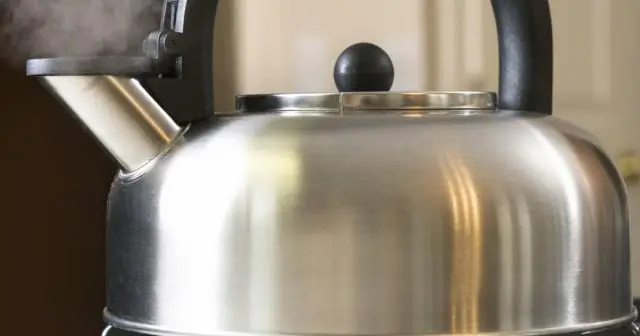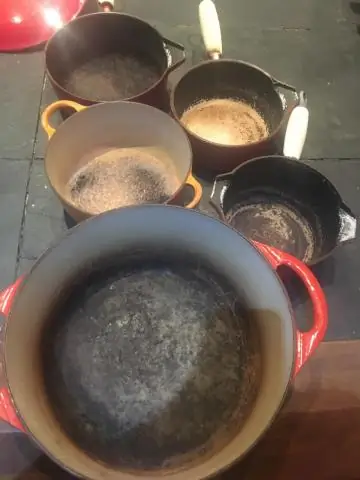
Table of contents:
- Author Bailey Albertson [email protected].
- Public 2023-12-17 12:53.
- Last modified 2025-06-01 07:32.
How to clean a stainless steel pot at home

One of the high quality and safe materials suitable for making cookware is stainless steel. These pots are distinguished by an unsurpassed appearance, as well as low thermal conductivity, which allows you to cook food in a short period of time. Steel does not crack, it does not enter into chemical reactions and does not have pores, in which many harmful bacteria accumulate. However, like any other dish, stainless steel pans are prone to various types of contamination. To wash the burnt dishes, remove carbon deposits, grease, stains from its surface by any housewife.
Content
- 1 Types of contamination on a stainless steel pan
-
2 What household chemicals to use for cleaning dishes
2.1 How to remove burn marks using "Whiteness"
-
3 How to remove dirt at home
- 3.1 Getting rid of burnt food with salt
-
3.2 A quick way to get rid of burning
3.2.1 An effective way to clean dishes using vinegar - video
- 3.3 How to wipe carbon deposits from the bottom and outside of the product with citric acid
- 3.4 How to clean dishes with hydrogen peroxide - video
-
3.5 How to clean a pot with soap
3.5.1 How to prepare a universal pot cleaner - video
-
3.6 How to clean stainless steel products inside and out
3.6.1 How to clean heavy dirt from carbon deposits with baking soda - video
- 3.7 Whey against any contamination
- 3.8 Activated carbon against burnt porridge
- 3.9 How to clean the dishes with coffee grounds
- 3.10 Ammonia against rainbow stains
- 3.11 Folk recipe using apple peel
- 4 How to care for a stainless steel pot
Types of contamination on a stainless steel pan
No one is immune from the annoying oversights that arise during cooking. Almost every housewife has encountered situations in her life when, due to her own inattention, the contents of the pan burned, spoiling the aesthetic appeal of the product both inside and outside.

A burnt pan is the most common stain on stainless steel
In such cases, you can use simple and reliable methods to effectively clean the dishes. They will help provide her with a truly sparkling look.
The main contaminants that most people who use stainless steel have to deal with are:
- burnt food debris;
- old fat;
- carbon deposits on the sides of the pan from the outside and inside;
- rainbow spots and stains.

Stains on stainless steel dishes can occur after the first use, as well as in connection with the use of lime water
What household chemicals to use for cleaning dishes
To clean a stainless steel pan, there are many tools, including specialized formulations available in stores. However, when using them, you should not use hard metallized scrapers and coarse brushes, as well as sand and emery paper, since all this can cause serious damage to the coating in the form of deep scratches.
Acidic liquids suitable for cleaning a variety of kitchen surfaces are suitable for cleaning stainless steel products. With their help, it is possible to easily get rid of traces of fat, as well as wipe off strong and old dirt that forms during the cooking process. If you prefer commercial products that can deal with the toughest dirt on the sides of pots, consider the following options.
- Chister. The cheapest tool, however, with less efficiency.
- "Bugs Shumanit". It contains aggressive components, has a good cleaning effect, and is sold at an average price.
- Oven Cleaner. Does not contain aggressive substances, does not have a smell, has the highest price in comparison with its counterparts.
Each of these products must be applied to a stainless steel surface, left to stand for 10 minutes, and then rinsed thoroughly with water. It should be remembered that the use of compounds with a complex chemical formula implies the mandatory use of gloves and the adherence to precautions to prevent the substance from getting on open skin or in the eyes. In addition, products such as Chister and Shumanit have a very strong odor. For this reason, it is advisable to clean pots with their help in a well-ventilated area.

When cleaning stainless steel pans, avoid products containing abrasive elements - they can scratch the surface of the product
How to remove burn marks using "Whiteness"
"Whiteness" is a very affordable tool that allows you to return stainless steel pans to their former chic. One tablespoon should be enough to clean a medium-sized saucepan.
- The substance in the specified amount must be poured into the water in a burnt pan, and then boil it for 30 minutes.
- Then the burn-in is cleaned with a sponge, then the utensils processed in this way must be boiled in clean water again, this will get rid of the peculiar smell and residues of "Whiteness" on its surfaces.

"Whiteness" is the most inexpensive chemical cleaner for cleaning stainless steel dishes
How to remove dirt at home
You can clean stainless steel pots with effective home methods. It is enough to use the tools at hand, which can be found in every home.
Getting rid of burnt food with salt
The method of cleaning the pan with salt is the simplest and most affordable.
- Pour cold water into a saucepan and let it sit for a while.
- Drain the water and put a few tablespoons of table salt on the bottom of the dish.
- After 2-3 hours, use a kitchen sponge to remove the remaining burnt food without using too much effort.

Salt will help to effectively deal with various types of pollution
A quick way to get rid of burning
One of the favorite methods of cleaning stainless steel pots for most housewives involves using vinegar. With its help, you can easily and easily clean the dishes from burning.

Vinegar is an excellent cleaner for cleaning stainless steel pots from burning
There are several methods for using vinegar to clean stainless steel. Let's consider the most effective ones. For the first method, you only need 9% vinegar.
- Pour 9% vinegar into a saucepan and leave for 2-3 hours.
- After the specified time has elapsed, thoroughly rinse the dishes with detergent.
For the second method, we use vinegar, water and laundry soap.
- Fill the pot with water.
- Pour into it ½ cup 9% vinegar with the addition of half a piece of 72% laundry soap.
- Boil the contents of the pan for 30-60 minutes.
An effective way to clean dishes using vinegar - video
How to wipe carbon deposits from the bottom and outside of the product with citric acid
To cope with strong carbon deposits, as well as lime deposits that appear on the walls of stainless steel pots, citric acid will help. For this:
- fill a pot with water and boil it. The water level should only cover the burn, so too much water will not be needed;
- put in boiling water 2 tbsp. tablespoons of citric acid powder and continue boiling for 15 minutes;
- drain the water and use a sponge to clean the burnt bottom. This process will be easy and will not take long.

Citric acid will help cleanse the pan
How to clean dishes with hydrogen peroxide - video
How to clean a pot with soap
Another simple and effective tool that allows you to cope with pollution of any complexity is ordinary liquid or laundry soap.
If there is a small amount of dirt caused by light burning, use the following method.
- Pour hot water into a saucepan.
- Pour soap solution into it and mix well.
- Boil the contents of the pot for 15-20 minutes.
- After the pan has cooled down, take a kitchen sponge and scrub the walls with a burn.

Liquid soap is effective against minor types of dirt
The following method will help to get rid of the most difficult and rather old contaminants.
- Measure out 4 liters of boiling water.
- Take a third of a bar of laundry soap and grate it, then add the shavings to boiling water.
- Add 1 tablespoon of PVA glue and place a saucepan in the resulting composition.
- Boil the product for 30 minutes.

Grated laundry soap will help get rid of old stains on stainless steel dishes
How to prepare a universal pot cleaner - video
How to clean stainless steel products inside and out
Almost every housewife knows that baking soda has excellent cleaning properties. With its help, you can clean a stainless steel pan not only outside, but also inside. To do this, you just need to apply the powder to the places of contamination, and then rub them with a sponge.

Baking soda has excellent cleaning properties
Use a deep container to clean the outside of the pot.
- Place the dirty dishes in a deep container.
- Prepare a soda composition (at the rate of 1 pack of soda (0.5 kg) for 5-6 liters of water) and fill them with dirty dishes. In this case, the water level should cover it by 2-3 cm.
- Put the container with the dishes on the fire, wait for the solution to boil, then continue boiling for two hours.
- Let the pots cool, then rinse them with water.

Use a large enamel bowl or bucket to clean the outside of a burnt pot.
How to clean heavy dirt from carbon deposits with baking soda - video
Whey against any dirt
With this method you can easily and easily get rid of dirt of varying complexity.
- Serum should be poured onto the bottom of the damaged pan, which should cover the contaminated surface areas 1-2 cm above their level.
- Leave the pan of whey for a day.
- Drain the solution and wash the dishes with a sponge.

Milk whey will give your pan the original look
Activated charcoal against burnt porridge
If your porridge burns out, activated charcoal will be an excellent tool for removing impurities. You can buy it at any pharmacy.

Activated carbon tablets - a budget and safe dish cleaner
- Take the required number of tablets and grind them thoroughly into powder.
- Sprinkle the dirt on the bottom of the dish with it.
- Add water to a saucepan until you get a gruel. Leave the resulting mixture for 30 minutes.
- After the time has passed, rinse the pan thoroughly with running water.
How to clean dishes with coffee grounds
The cleaning agent, which has the same principle of action as activated carbon, and also allows you to get rid of various contaminants on the walls of stainless steel pots, is coffee grounds. Collecting it every time after drinking your favorite drink, you will be able to clean stainless steel dishes efficiently without harming it.

Coffee grounds will help you clean stainless steel dishes
- Take a regular kitchen sponge, dab some coffee grounds on it and wipe the dirty areas.
- Then rinse the pan with water. Thanks to this method, yours will again delight you with a beautiful shine of metal.
Ammonia against rainbow stains
If there are stains on the surface of the stainless steel pan, ammonia will help to deal with them.

Ammonia will help get rid of rainbow stains on dishes
- To do this, take a toothpaste that does not contain whitening microparticles and mix it with ammonia to make a solution.
- Take a cleaning cloth, soak it in the resulting liquid, and rub the surface of the pot.
- Rinse off the solution with cold water.
Folk recipe using apple peel
Another popular method will help rid your pans of a lot of dirt. This will require the peel of several sour apples.
- The peel must be put in a saucepan and covered with water.
- Then put the container on fire and boil for 15-20 minutes.
- Then you should clean the pan in the usual way. Accumulated dirt can be removed without effort.
This method is not very effective, however, it can be used to cope with small dirt that has arisen on the walls of the dishes.

Apple peel will help deal with light dirt
How to care for a stainless steel pot
During use on stainless steel pans, a layer of grease begins to form over time, which can accelerate surface wear. Dish care means daily high-quality cleaning.
- After finishing the cooking process, the dishes should be rinsed with sufficient water and detergent. This will help prevent the possibility of dark spots and get rid of dried-on food particles. It should be remembered that according to the recommendations of the manufacturers of stainless steel dishes, the washing process must be started some time after use. This will protect the coating from destruction due to a sharp temperature drop.
- It is not recommended to clean stainless steel pans with abrasive materials or metal scrapers, which can scratch the surface.
- The use of dishwashers is not recommended. It is advisable to wash the dishes in warm water, using soft sponges. However, if the information in the instructions for use of the product confirms the possibility of using the dishwasher, it is advisable to pre-soak the dishes in soapy water. This will allow you to more efficiently and safely deal with various types of pollution using modern technology.
- After washing, it is advisable to wipe the pan dry, as water droplets on its surface can cause stains.
- It is best to wipe the dishes with dotted movements, which give the surface not only perfect cleanliness, but also smoothness.
-
You can use raw potatoes to add shine to stainless steel items. Cut it in half and use these halves to rub the entire surface of the pot.

clean stainless steel pans Stainless steel pots need daily care
Cleaning pots using the listed methods will ensure the dishes look great, as well as take care of their long-term use. In addition, hand-made cleaning products can be the key to reasonable savings and guarantee an excellent effect, comparable to purchased counterparts.
Recommended:
How To Clean The Microwave From Fat Inside And Outside Quickly And Easily + Video

Practical step-by-step tips for cleaning your microwave oven from grease and dirt inside and out. Means used, precautions
How To Clean An Electric Oven Outside And Inside From Carbon Deposits And Grease: Catalytic And Other Types Of Cleaning + Video

How to clean an electric oven from dirt and carbon deposits inside and out: using chemistry, folk remedies and self-cleaning technologies
How To Clean A Burnt Enamel Pan, How To Remove Carbon Deposits, Dark Deposits And Burnt Food At The Bottom

Types of contamination of enamelled pots and how to remove them. How to clean a burnt enamel pot without damaging the coating
How To Clean An Aluminum Pan At Home, How To Clean It From Blackness, Carbon Deposits, Burnt Food Inside And Out

Types of contamination of aluminum pans and methods of dealing with them. How to clean aluminum dishes at home: effective recipes. Care advice
How To Clean The Pan From Burnt Jam Or Sugar (enamel, Stainless Steel, Etc.)

How to clear burnt sugar or jam from a saucepan. Effective cleaning methods for aluminum, enamelled and stainless steel pots and pans
